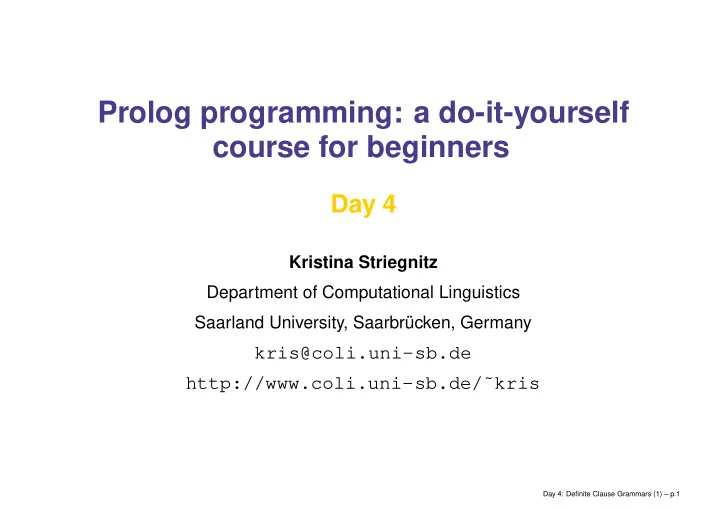

Prolog programming: a do-it-yourself course for beginners Day 4 Kristina Striegnitz Department of Computational Linguistics Saarland University, Saarbr¨ ucken, Germany kris@coli.uni-sb.de http://www.coli.uni-sb.de/˜kris Day 4: Definite Clause Grammars (1) – p.1
Day 4: Definite Clause Grammars (1) Today: Grammars as Prolog programms for recognizing natural language sentences. Reader: Lecture 7 of Learn Prolog Now! Day 4: Definite Clause Grammars (1) – p.2
Today’s goal: a NL recognizer A Prolog programm for the following task: Given • a grammar specifi cation, • a list of words, and • a syntactic category C , is the list of words a grammatical expression of category C ? Day 4: Definite Clause Grammars (1) – p.3
Some examples S → NP VP catgory: S words: [the,nurse,whistles] ➜ yes NP → Det N NP → PN category: NP VP → Vi words: [the,whiskey] ➜ yes VP → Vt NP category: NP Det → the words: [drinks] ➜ no Det → a category: VP PN → gogo words: [fights] ➜ no N → nurse N → whiskey Vi → whistles Vt → drinks Day 4: Definite Clause Grammars (1) – p.4
Strategy For each syntactic category C , defi ne a predicate c(InList,OutList) which takes a list of words ( InList ) as input, “bites off” a sequence of words corresponding to an expression of category C and returns the rest ( OutList ). Day 4: Definite Clause Grammars (1) – p.5
Examples ?- np([the,nurse,whistles],Out). Out = [whistles] ?- np([the,whiskey],Out). Out = [] ?- vt([drinks,the,whiskey],Out). Out = [the,whiskey] ?- vp([nurse,whistles],Out). no Day 4: Definite Clause Grammars (1) – p.6
Definite Clause Grammars (DCGs) — words Let’s start with single words: If the head of the input list is the word bride , n([bride|Out],Out). n([nurse|Out],Out). then we have found a noun. Return the tail of n([sword|Out],Out). the list. det([the|Out],Out). pn([bill|Out],Out). vt([kills|Out],Out). . . . Day 4: Definite Clause Grammars (1) – p.7
DCGs — complex categories Now, we can build more complex categories: np(In,Out) :- det(In,DetOut), n(DetOut,Out). If we can bite a determiner off the list and then bite a noun of the list, then we have found an NP . Return what’s left when biting off the determiner and the noun. np(In,Out) :- pn(In,Out). If we can bite a proper name off the list, then we have found an NP . Return what’s left when biting off the proper name. vp(In,Out) :- vi(In,Out). vp(In,Out) :- vt(In,VtOut), np(VtOut,Out). s(In,Out) :- np(In,NPOut), vp(NPOut,Out). Day 4: Definite Clause Grammars (1) – p.8
s(In,Out) :- np(In,NPOut), How does this work? vp(NPOut,Out). np(In,Out) :- det(In,DetOut), s([the,bride,kills,bill],[]) n(DetOut,Out). np(In,Out) :- pn(In,Out). np([the,bride,kills,bill], I1) vp(In,Out) :- vi(In,Out). vp(I1,[]) vp(In,Out) :- vt(In,VtOut), det([the,bride,kills,bill],I2) np(VtOut,Out). n(I2,I1) vp(I1,[]) det([the|Out],Out). . I2=[bride,kills,bill] . . n([bride,kills,bill],I1) vp(I1,[]) I1=[kills,bill] vp([kills,bill],[]) vt([kills,bill],I3) vi([kills,bill],[]) np(I3,[]) I3=[bill] np([bill],[]) pn([bill],[]) det([bill],I4) n(I4,[]) Day 4: Definite Clause Grammars (1) – p.9
DCGs in Prolog Prolog provides a simpler notation for specifying DCGs. s --> np, vp. → s(In,Out) :- np(In,NPOut), vp(NPOut,Out). np --> det, n. np(In,Out) :- det(In,DetOut), n(DetOut,Out). → np --> pn. → np(In,Out) :- pn(In,Out). vp --> vi. → vp(In,Out) :- vi(In,Out). vp --> vt, np. vp(In,Out) :- vt(In,VtOut), np(VtOut,Out). → n --> [bride]. → n([bride|Out],Out). det --> [the]. det([the|Out],Out). → vi --> [whistles]. → vi([whistles|Out],Out). vt --> [kills]. vt([kills|Out],Out). → Internally, Prolog uses this notation. Therefore: ?- s([the,nurse,whistles],[]). to ask whether [the,nurse,whistles] is a sentence. Day 4: Definite Clause Grammars (1) – p.10
Adding Pronouns Here is our DCG: s(In,Out) :- np(In,NPOut), vp(NPOut,Out). np(In,Out) :- pn(In,Out). np(In,Out) :- det(In,DetOut), n(DetOut,Out). vp(In,Out) :- vi(In,Out). vp(In,Out) :- vt(In,VtOut), np(VtOut,Out). n([bride|Out],Out). det([the|Out],Out). pn([bill|Out],Out). vt([kills|Out],Out). Imagine we want to add the pronouns vi([whistles|Out],Out). he, she, him, her ... Day 4: Definite Clause Grammars (1) – p.11
Adding Pronouns — first try s(In,Out) :- np(In,NPOut), vp(NPOut,Out). np(In,Out) :- pn(In,Out). np(In,Out) :- det(In,DetOut), n(DetOut,Out). vp(In,Out) :- vi(In,Out). vp(In,Out) :- vt(In,VtOut), np(VtOut,Out). n([bride|Out],Out). np(In,Out) :- pro(In,Out). det([the|Out],Out). pn([bill|Out],Out). pro([he|Out],Out). vt([kills|Out],Out). pro([she|Out],Out). vi([whistles|Out],Out). pro([him|Out],Out). pro([her|Out],Out). ?- s([she,kills,him],[]). yes Need to distinguish between ⇒ ?- s([him,kills,she],[]). subject and object pronouns. no Day 4: Definite Clause Grammars (1) – p.12
Adding pronouns — second try We use an extra argument to mark whether an NP or a pronoun is in subject or in object position. s(In,Out) :- np(subj,In,NPOut),vp(NPOut,Out). vp(In,Out) :- vt(In,VtOut),np(obj,VtOut,Out). np(CASE,In,Out) :- pro(CASE,In,Out). pro(subj,[he|Out],Out). pro(subj,[she|Out],Out). pro(obj,[him|Out],Out). pro(obj,[her|Out],Out). np( ,In,Out) :- pn(In,Out). np( ,In,Out) :- det(In,DetOut), n(DetOut,Out). Day 4: Definite Clause Grammars (1) – p.13
s(In,Out) :- np(subj,In,NPOut),vp(NPOut,Out). Example np( ,In,Out) :- det(In,DetOut),n(DetOut,Out). np( ,In,Out) :- pn(In,Out). np(CASE,In,Out) :- pro(CASE,In,Out). vp(In,Out) :- vi(In,Out). vp(In,Out) :- vt(In,VtOut),np(obj,VtOut,Out). pro(subj,[he|Out],Out). pro(obj,[her|Out],Out). . . . s([her,kills,bill],[]) np(subj,[her,kills,bill], I1) vp(I1,[]) det([her,kills,bill],I2) n(I2,I1) vp(I1,[]) pn([her,kills,bill],I1) pro(subj,[her,kills,bill],I1) vp(I1,[]) vp(I1,[]) Day 4: Definite Clause Grammars (1) – p.14
Extra arguments in the --> notation s --> np( subj), vp. → s(In,Out) :- np(subj,In,NPOut), vp(NPOut,Out). np( ) --> det, n. np( ,In,Out) :- det(In,DetOut), → n(DetOut,Out). np( ) --> pn. → np( ,In,Out) :- pn(In,Out). np(CASE) --> pro(CASE). np(CASE,In,Out) :- pro(CASE,In,Out). → vp --> vi. → vp(In,Out) :- vi(In,Out). vp --> vt, np(obj). vp(In,Out) :- vt(In,VtOut), → np(obj,VtOut,Out). To query: ?- s([the,nurse,whistles],[]). ?- np( ,[the,bride],[]). Day 4: Definite Clause Grammars (1) – p.15
Practical Session Write your own DCG. http://www.coli.uni-sb.de/˜kris/esslli04prolog Day 4: Definite Clause Grammars (1) – p.16
Recommend
More recommend